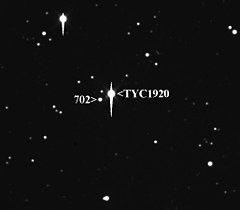Pronunciation /əˈlɔːdə/ ə-LAW-də Minor planet category Main belt Discovered 16 July 1910 Discoverer Joseph Helffrich Moon S/2007 (702) 1 | Discovery date 26 July 2007 Alternative names 1910 KQ Observation arc 105.76 yr (38628 d) Orbits Sun Asteroid group Asteroid belt | |
 | ||
Discovery site Heidelberg-Königstuhl State Observatory Similar 423 Diotima, 107 Camilla, 121 Hermione, 375 Ursula, Asteroid belt | ||
702 Alauda is a large asteroid 7005195000000000000♠195±3 km in diameter. It was discovered in 1910 by Joseph Helffrich from the observatory at Heidelberg University. It is named after the lark (alauda). In 2007, a small moon, named Pichi üñëm, was discovered.
Contents
Satellite
Alauda's satellite Pichi üñëm (provisionally known as S/2007 (702) 1) was discovered from observations using adaptive-optics imaging with the European Southern Observatory (ESO) 8-m Very Large Telescope (VLT) on Cerro Paranal, Chile. It is 5.5 km in diameter and has a projected separation from Alauda of 900 km. It was named Pichi üñëm, meaning "little bird" in the Mapuche language of Chile, the country from which the moon was discovered.
Orbital characteristics
Alauda has been identified as the largest member of a dynamical family. Other members of this family include: 581 Tauntonia, 1101 Clematis, 1838 Ursa, 3139 Shantou, 3325 TARDIS, 4368 Pillmore, 5360 Rozhdestvenskij, 5815 Shinsengumi, and many others. Alauda's moon may be a result of the collision that created the asteroid family.
Physical characteristics
The discovery of Alauda's moon enabled Alauda's mass to be determined. Rojo and Margot (2010) have estimated its mass to be 6.06×1018 kg with a density of 1.57 g/cm³.
Occultations
Alauda has been observed to occult stars on several occasions, providing important information on its size and shape. It produced occultations on 2001-07-12 and 2004-04-21. It may have occulted an apparent magnitude 9.5 star in the constellation of Gemini on 2009-10-17 at 08:18 UT. This event should have been visible from Uruguay, Argentina, and Chile.
